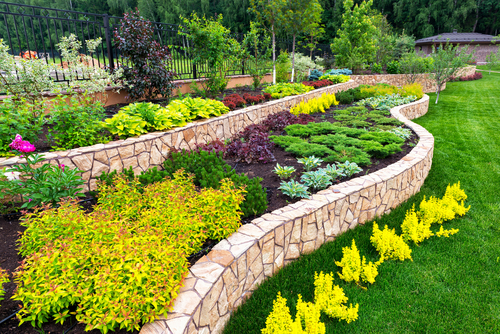What is Landscape Design?
The term “aesthetics” is often associated with landscaping, as it means “concerned with beauty or the appreciation of beauty.” While good landscaping comes off as effortlessly gorgeous, making it actually happen requires a knowledge and application of aesthetic principles.
At Darlington Designs, we offer professional landscape services that draw on our deep knowledge of aesthetic principles. Our strength is helping you discover what you most desire for your outdoor area, and then turning that into a reality through sound design and careful construction. Thoughtful landscape design is key to creating an outdoor space that harmonizes well with the particularities of your property (size, geography, etc).
But what is landscape design, exactly?
Landscape design integrates a wide variety of elements to achieve beautiful, functional spaces for outdoor living. A well-executed landscape will not only increase your enjoyment at home, but also expands your available living space. And studies suggest, when it’s done right, landscaping can boost your property value by up to 15%. So what are you waiting for?
Do You Know These Key Principles of Landscape Design?
Take a look at four principles of landscape design to help you start thinking about what you want for your future garden.
1. Focal Point
A focal point is where your eye lands naturally when taking in a scene. By forcing your attention to a particular location, focalization establishes purpose and order within the space. Without it, a landscape can devolve into a sprawling collection of plants and other objects.
Achieving focalization doesn’t have to be difficult. Just adding an accent to an open space automatically creates a focal point. Perhaps you have landscape architecture such as an arbor or garden shed that you’d like to highlight. If you select a plant, just be sure that it’s able to stage strong interest throughout the season.
Once you’ve decided where to place your focal point, the rest of the landscape should be designed to accentuate it. Our professional landscapers can help by creating natural lines with flower beds and other objects to maximize the effect of a focal point. These natural lines become the axis of the garden, upon which further landscaping can be elaborated.
2. Balance
 To understand the concept of balance, you should think of plants and objects as having visual weight. While some items are short and circular, others might be tall and rectangular. Creating balance means bringing all the different elements of the garden into equilibrium.
To understand the concept of balance, you should think of plants and objects as having visual weight. While some items are short and circular, others might be tall and rectangular. Creating balance means bringing all the different elements of the garden into equilibrium.
Balance can be either symmetrical or asymmetrical. Symmetry refers to the way elements are arranged identically around a central axis. A good example is foundation planting in your front yard, where you will likely have the same number of bushes and similar arrangements of flowers on each side.
Asymmetry, on the other hand, is not balanced and does not follow a disciplined pattern. For example, a traditional Japanese garden has stone pathways and plants that appear to be randomly placed, but repetition creates a sense of equilibrium regardless of the angle it’s being viewed from.
3. Repetition
The use of repetition in landscape design creates a sense of cohesiveness. While contrast is used to introduce variety through texture, form, height, and color, repetition draws all these elements together into a unified whole.
You can repeat plants at several points in the garden, or repeat aspects of plants––such as using similar texture, height, and form. Color is an especially important motif to show the interconnectedness of different parts of the garden. You can also enhance repetition with architecture, benches, or other garden objects!
4. Rhythm
Incorporating rhythm in a landscape design allows you to insert flow and movement. However, it’s not the plants that are moving, but rather the perspective of the person viewing the garden.
When rhythm is applied effectively, the eye is drawn to follow a visual pattern through the garden. For example, placing a stone sculpture amidst a bed of low-growing perennials creates a sense of movement because the eye must travel around the interruption.
Similarly, a curving path introduces rhythm by causing the viewer to explore what lies beyond. A few more examples of ways to put rhythm into your landscape include:
-
- Disrupt a repetitive element with a different shape or color.
- Create a slow rhythm along a path by spacing stepping stones farther apart.
- Repeat an element like columns or plant forms in a linear or cyclical pattern.
Landscape Your Property with Darlington Designs
Achieving a gorgeous landscape at your home doesn’t have to be a pipe dream. With Darlington Designs, you get the best of both personalization and professional expertise. No two landscapes we create are the same because every client and property is different.
Our work focuses on eliciting your ideas for the space and then offering recommendations and landscape design drawing. Through this collaborative process, we help you create the garden you’ve always longed for but perhaps couldn’t fully imagine—until now!
To learn more about what it would look like to choose Darlington Designs for your next home improvement project, we encourage you to check out our free Ebook, “The Darlington Difference.”
You can also call us to set up a design consultation at 856-442-0440.



